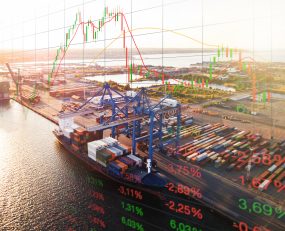
Since the outbreak of the COVID-19 pandemic, and particularly since autumn 2020, sea freight rates have risen substantially and are still at extraordinarily high levels. But even by the standards of the past year, the rates reported in the Freightos Baltic Index, which collates millions of transactional spot rates per month, are extraordinary.
The latest average weekly data for June 4, 2021, shows a price of $10,492 per FEU with the latest daily data showing $10,882 per FEU for June 7, 2021, which compares to a price of $1,794 a year ago and year-on-year growth of 506.8%. What’s worse for shippers is that these figures do not include the surcharges of $1,500-$2,500 which shipping lines are imposing to guarantee access to equipment and on-time movements of freight.
Freightos Baltic Index
Source: Freightos
The dramatic increase can largely be attributed to a market where the surge in demand has far outpaced the increase of supply on this lane, compounded by supply chain disruption which has taken available capacity out of the market, not to mention rising bunker fuel prices.
Demand has been driven by Europe’s recovery from the pandemic and a restocking cycle which reached its peak In Q1-21. In terms of volumes at European ports, Rotterdam reported a 4.5% year-on-year increase in TEUs in Q1-21 and Antwerp reported just a 2% rise for the same period. However, tellingly the Port of Hamburg reported a 16% increase in volumes from China in Q1-21.
Shipping lines have been increasing capacity on the Asia to Europe lane but they have struggled to match the pace set by demand. These problems have been intensified as capacity has been held back by disruption at ports, the fall-out from the Suez blockage and equipment shortages leading shipping lines to blank badly needed sailings. Measured by Alphaliner’s Top 100, sea freight capacity on the Asia to Europe lane has increased by 7.7% from January 5, 2021, to June 7. The growing disparity between the 16% increase in volumes on the Asia to Europe lane reported by Hamburg and the 7.7% increase in capacity illustrates the upward price pressure on this lane. Another factor that has been exerting upward pressure on rates has been bunker fuel prices, which according to Platts have almost doubled in the past six months.
The effects of this crisis have also been felt on the contract market for sea freight, though less severely. Xeneta’s XSI, which provides a monthly measure of contract sea freight rate development, showed a 3.9% month-on-month increase in prices for sea freight imports to Europe in May and a 51.3% increase year-on-year.
XSI – Europe Imports / Exports
Source: Xeneta
Many of the same drivers of demand and restrictions on capacity that have resulted in high spot rates are also pushing up contract rates, consequently, we have seen contract rates follow the direction of spot rates over the past six months, though with less dramatic increases. Spot rates remaining so high is itself placing continuing upward pressure on contract rates. Forwarders and shipping lines are able to squeeze shippers wary of leaving themselves with no option but to pay sky-high spot rates to secure capacity. This has led many shippers to move on to short term contracts with terms shorter than one year, willing to pay higher prices for a few months in the hope of a better deal later in the year. Of course, the wisdom of this approach remains to be seen, but the trend for contract terms shortening is also likely to contribute to sustained price volatility for the foreseeable future.
Source: Transport Intelligence, June 8, 2021
Author: Michael Clover
For more data and analysis of sea freight rate development, you can take a look at Ti’s Global Supply Chain intelligence (GSCi) platform, which tracks freight rates, volumes and capacity.
To read more about the implications of high freight rates for the sea freight forwarding market check out Ti’s new report Global Freight Forwarding 2021.